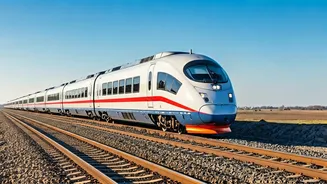Project Overview
The Union government's approval of the fourth railway line between Tambaram and Chengalpattu marks a crucial infrastructure investment. This project is specifically
designed to address the increasing congestion experienced by commuters in this busy section of the Chennai Suburban Railway network. The initiative falls under the broader strategy to expand and improve railway services across the nation. The new line's primary aim is to enhance capacity, reduce delays, and provide a more reliable travel experience. This project will allow for the separate movement of passenger and freight trains. The Tambaram-Chengalpattu section is a vital link, serving a significant number of daily passengers. The project aims to improve operational efficiency and provide a higher standard of service for those who depend on the railways for their daily commute.
Addressing Congestion
One of the most pressing issues this fourth line aims to resolve is the persistent congestion that plagues the Tambaram-Chengalpattu route. As the Chennai Metropolitan area continues to expand, so does the demand for efficient public transport. Currently, the existing lines are often overloaded, resulting in frequent delays and disruptions. By adding a dedicated track, the project will effectively increase the line's capacity. This means more trains can operate simultaneously, leading to shorter wait times and a smoother flow of traffic. The enhanced infrastructure will not only benefit daily commuters but will also have a positive impact on freight services. Reduced congestion ensures that goods reach their destinations more quickly, thus boosting economic activity. This project demonstrates a proactive step in managing the growth and ensuring the railway network meets the demands of a growing urban population.
Impact on Commuters
The approval of the fourth line carries numerous benefits for the everyday commuter. A more frequent and punctual train schedule is expected as the increased capacity allows for more trains to run throughout the day. This improvement will be particularly crucial during peak hours, when overcrowding is most severe. The project should significantly reduce travel times, allowing people to spend less time commuting and more time on other important activities. Increased reliability also means commuters can better plan their journeys. The overall improvement in services contributes to a more convenient and pleasant travel experience. Furthermore, the modern infrastructure often leads to improved safety measures and passenger comfort, making railway travel a more attractive option for people in and around Chennai.
Infrastructure Upgrades
This railway project encompasses more than just laying down an additional track; it signifies a comprehensive infrastructure upgrade. In addition to constructing the fourth line, there will likely be upgrades to signaling systems and station facilities. Modern signaling technologies enhance the safe and efficient movement of trains, improving the overall operational capacity. Station improvements might include expanded platforms, better waiting areas, and improved passenger amenities. These upgrades enhance the entire passenger experience from beginning to end. Proper infrastructure upgrades are crucial for ensuring the long-term sustainability and effectiveness of the railway system. The integration of modern technologies will ensure that the railway infrastructure meets the demands of a growing urban population and the technological advancements in railway transportation.
Future Implications
The Tambaram-Chengalpattu fourth line project represents a crucial investment in Chennai's future, influencing further expansion and development. This undertaking aligns with broader strategies to enhance transport and infrastructure across the country, aiming to support the overall economic growth and improved quality of life for the residents. By improving railway services, the government is also promoting a more sustainable mode of transportation, reducing the city's dependence on road traffic and thus improving air quality. The success of this project could serve as a model for similar developments in other congested railway corridors across the country, emphasizing the role of efficient infrastructure in facilitating economic growth and improving the quality of life.















